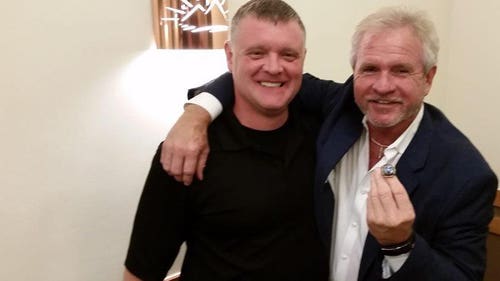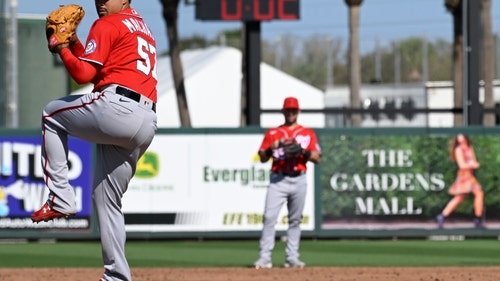
Toronto Blue Jays: The Mercenary's Creed
When looking back at the glory years of the Toronto Blue Jays baseball club and reveling in their momentous accomplishments spread over the 1992 &1993 seasons, one is often struck by the delicious irony in how their rosters were assembled into an eventual formula worthy of legendary success. Throughout the better part of the decade leading up to their window of competition (1984-1991) the Blue Jays were renowned for their gradual development of upper crust talent vis-à-vis strategic drafting efforts, brilliant scouting personnel, and cagey international signings.
Their vaunted outfield trio of George Bell (Rule 5 in 1980), Lloyd Moseby (2nd overall in 1978), and Jesse Barfield (9th round in 1977) was the direct result of shrewd timing and calculated risk. Dave Stieb (140 wins in the decade) was scouted at a varsity game as an outfielder and converted into one of the game’s most dominant starters. Tony Fernandez was discovered by uber scout Epy Guerrero as an undrafted free agent and was considered to be one of the best shortstops in the American League. Kelly Gruber was a Rule 5 Draft reclamation project after failing to catch on with Cleveland. Tom Henke joined the team after the 1981 baseball strike as a compensatory pick.
Needless to say, the calm before the World Series storm revealed a franchise bent on developing young players into household names. But after failing repeatedly to advance beyond front office expectations (1985, 1987, 1989, 1991), it was determined that a change in roster building philosophy was necessary – and so management looked to hired guns, daring trades, and big free agent contract signings to help bolster their chances at nabbing the big one.
They were our four horsemen of the baseball apocalypse; the dark savants who thwarted promising Jays rosters struggling mightily to reward their suffering fanbase with a glimmer of championship gold – and yet all four of these diamond ronins who were so instrumental in preventing such a reality ended up rallying to the Great White North, joining the feverish pursuit of World Series glory, and in doing so transformed the baseball landscape in Toronto as we know it:
Jack Morris
Morris was easily the most feared and intimidating pitcher during the 1980’s – a veritable mix of Darth Vader, a grizzled bulldog, and an awkward uncle bent on ensuring defeat at all costs. To many fans of the Blue Jays, he epitomized everything that prevented their team from ascending to greater heights by repeatedly thwarting their efforts at every conceivable turn. He was also the only right-handed starter with more wins in the decade than Dave Stieb.
A towering right-hander who brandished the kind of moustache normally reserved for brawling gunslingers in the Wild West, Morris finished his career with 254 wins and seven top 10 Cy Young award finishes – with the most innings pitched, game started, and wins during the entire decade. He led the Tigers in wins from 1979-1988, the kind of streak reserved for Hall of Fame worthy consideration – yet somehow only managed to top out at 67.7% of support for Cooperstown. You’d think that his 293.2 innings pitched in 1983 alone would have been enough to convince anyone that he was more than deserving of the honour, but a careful examination reveals that Stieb was actually more valuable as a starter.
What set him aside from his contemporaries was a seemingly indomitable will to crush opponents with sheer ferocity. And so it came as no surprise when, hot on the heels of his mercurial game seven 10-inning shutout against the Atlanta Braves in 1991 – generally regarded as the one of the greatest post-season pitching performances of all-time, Toronto came calling during the winter to entice an old foe to join the fray. In essence, the Jays made him the richest pitcher in the game, signing him to a two-year contract worth $10.85 million dollars.
Virtually all of his old teammates are in agreement that Morris should be in the Hall of Fame and that he was the catalyst behind their first championship run. Although his post-season performances with the Jays were underwhelming, many agree that without his 21 wins in1992, his signature swagger and “take no prisoners” mentality, it’s doubtful the team would have prevailed in their quest for champagne glory. Furthermore, the signing of Morris itself represented the first time in the history of the Toronto franchise that a high-ticket free agent was prepared to head north of the border and shattered any notion that the Blue Jays weren’t ready for prime time.
Dave Stewart
Stewart was remembered for many accolades during his time in professional baseball. He was a three-time World Series winner, was the most valuable player multiple times in the playoffs, threw a no-hitter against Toronto in 1990, and pitched for six different clubs.
But when it came to the Blue Jays, he will always be remembered for his infamous death stare and fiercely competitive posture – a poetic conflux of a heat-seeking ICBM missile mixed with a devastating forkball wielding sentinel capable of shutting down the most potent of lineups in the game. It wasn’t until his collaboration with the famed Oakland Athletics pitching guru, Dave Duncan, that Stewart took his game entirely to new heights.
Between 1987 and 1990, he finished in the top five of Cy Young voting and averaged 21 wins and 260 innings pitched per season – as feared a hurler as you’ll find in the business. His expanded repertoire of pitches and uncanny composure on the mound literally turned him into an overnight star. Sadly, he would never replicate the success experienced during this era while under the tutelage of Duncan.
Stewart would leave the Oakland Athletics under dubious circumstances, feeling slighted by the team during a period of irrefutable dominance against the American League – in particular, against the Blue Jays (between 1987-1990, 8-3 with an ERA under 2.00). Without a doubt, this was the lasting impression which compelled Toronto to pursue him relentlessly during the off-season until he signed a two-year, $8.5 million dollar contract, solidifying their rotation in pursuit of back-to-back championships.
He would go on to thrill the faithful with timely post-season heroics and captured the ALCS MVP against the White Sox as a proud member of the Blue Jays. Winning both of his games on the road in Comiskey Park in rather convincing fashion (3-1, 6-3), the former historical nemesis had come full circle in his career, and became a World Series champion for the third time in a city that would leave an indelible mark on his career.
Paul Molitor
Molitor was essentially born to be a Blue Jays villain. One of only five men in the history of baseball to have at least 3,000 hits, a .300 lifetime batting average, and 500 stolen bases – this Milwaukee Brewers legend was the scourge of the American League East back when the team was in the same division as Toronto. Every trip to County stadium between 1977-1991 was essentially a journey into the excruciating confines of a mid-western township ruled by the notoriously wicked hitting duo of Molitor and Robin Yount.
Much to the amazement of the Jays, Paul became available during the winter of 1992 during the free agency period after his lifelong team offered him a one-year contract with an untimely pay cut. In stepped the Blue Jays, fondly remembering previous seasons of Molitor dominance against their club (.391 in 1982, .380 in 1989, .304 in 1992) and ultimately undertaking a controversial decision at the time – replacing fan favourite Dave Winfield and changing direction with the younger Molitor on a three-year, $13 million dollar deal.
And thus WAMCO was born – the greatest collection of hitters the franchise could assemble to help navigate their second championship journey. With Molitor in tow, the Jays were an unstoppable hitting machine capable of annihilating any American League pitcher on any given day. If not for Olerud and Alomar splitting MVP votes for that year, it’s likely Paul could have won the award single-handedly. As an encore to his brilliant regular season, he would go on to hit .500 in the World Series against the Phillies while providing breathtaking memories for fans of the team to cherish for a lifetime.
By the time the dust had settled on his career, Molitor would emerge as one of the greatest hitters ever to play the game and was a first ballot Hall of Famer in 2004. His decision to join the Blue Jays after 15 years with the same team was not only vindicated with a trophy, but further underscored his value as a mercenary whose time had finally come.
Rickey Henderson
Henderson was a player who was simply larger than the sport itself. His exploits transcended baseball in ways that are still being felt today, culminating in a Cooperstown career which now houses the man who scored the most runs (2,295) and had the most stolen bases (1,406) of any player in the history of the game. His resume reads like a baseball fairy tale: 10 all-star games, three silver sluggers awards, leading the league 12 times in stolen bases, a gold glove, an MVP award, and two championship trophies. He also played for 10 different major league franchises.
During the 1980’s, Henderson defined the art of stealing bases. His imposing presence at the plate and dynamic overtures on the base paths was as much a product of the era as it was the extension of a profoundly gifted player whose thirst and passion for the game was evident throughout a quarter-century obsession with greatness. Against Toronto, Rickey was arguably the most feared player to ever visit Exhibition Stadium, stealing 38 bases during the decade and hitting over .300 in 1984, 1986, 1988, and 1990.
The Blue Jays came calling in 1993 when they traded Steve Karsay and Jose Herrera in what will remain one of the best answers to a trivia question used to impress dinner guests. Although Rickey performed poorly at the plate (.215 in 44 games during the regular season, .120 in the ALCS, .227 in the WS), his intimidating presence and blazing speed (22 stolen bases) contributed to a killer instinct never before seen in this market.
With him in the lineup, it felt like the entire organization had reached the pinnacle of respect and admiration, and that was abundantly obvious in the way opposing pitchers and managers began treating the Blue Jays; not as a team that could win, but as a team that should win – with serious players led by a serious front office prepared to do anything, and everything, to give their fans what they truly deserved: a World Series championship.
More from Jays Journal
This article originally appeared on











